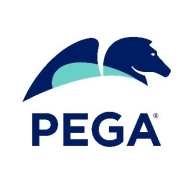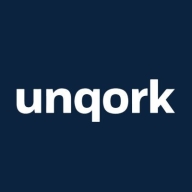

Pega Platform and Unqork are major contenders in the low-code and no-code application development category, respectively. Pega holds an advantage with its enterprise-level solution capabilities, thanks to its robust case management and integration features, while Unqork excels with its advanced no-code platform, simplifying development processes.
Features: Pega Platform focuses on rapid prototyping, offering a robust low-code environment that supports quick application development and enterprise scalability. It is particularly strong in case management, enhanced digital agility, and workflow automation. Unqork emphasizes no-code simplicity and AI-driven features, providing enterprise integrations and pre-built functionalities that enhance user experience. Its drag-and-drop capabilities facilitate rapid development and seamless integration with various systems.
Room for Improvement: Pega Platform requires enhancements in user interface design, better licensing options, and improved integration capabilities. There is also room for advancing AI functionalities and simplifying the deployment process. Unqork could strengthen accessibility compliance, its platform support, and analytics capabilities. Improving mobile performance and design flexibility would enhance its offering, alongside advancements in grid functionalities and technical support.
Ease of Deployment and Customer Service: Pega offers flexible deployment options, including on-premises and various cloud environments. However, its technical support is sometimes criticized for delays in handling complex issues. Unqork is primarily focused on public cloud deployment, with support for on-premises setups. It is praised for its effective customer service, although it comes with a relatively high cost.
Pricing and ROI: Pega Platform is often seen as expensive, reflecting a model where licensing costs depend on user numbers and cases, making it more suitable for large enterprises. Despite its high cost, Pega offers substantial ROI through process improvements and efficiency. Unqork, while priced on the premium side, delivers competitive value through its rapid deployment and productivity enhancements, offering a significant ROI although individual certification costs might add up.
The platform provides default workspaces, and managing or increasing space is easier compared to other platforms.
Using Unqork has resulted in improved cost-saving, time-saving, and resource-saving benefits for our projects.
Two to three projects saw a twenty to thirty percent reduction in workload, indicating a profitable pricing structure.
I never needed support from the platform standpoint, but if additional features are required, we have regular meetings with the product team for feedback.
The technical support from Pega is very low, rating a one or two out of ten.
Pega's technical support team is very helpful.
I rate their technical support as excellent.
The Unqork community portal and academy provide extensive information, with 60 to 70% of required information readily available.
The Unqork community helped integrate features like colored status indicators using JavaScript.
Currently, big banking providers and insurance providers, even the members for healthcare payers, are using more than millions of operations on a daily or weekly basis.
Its cloud infrastructure simplifies global access to data and services without the fear of losing data.
Scalability features like UI and APIs are all available within the same platform, making it easy to handle increased demands.
Not every project can be executed through Unqork as some complex requirements might need proof of concept before proceeding.
A component's previously set value might be missing the next day, affecting reliability.
The main issue I have with Unqork is the limited availability of learning resources.
There have been no significant stability issues where the entire platform went down.
Pega introduced Constellation, which allows a user to build a more engaging visual experience.
For customer interactions, while the Pega Platform's AI-based decisioning and predictive analytics are great, the Process AI is not very popular yet, as it works on process data rather than customer data.
My learning curve in robotics has been challenging.
Unqork moved from the Sanctuary to Vega platform without providing a migration tool, necessitating manual updates.
The setup for API calls was initially challenging, especially when dealing with service logs and transforming large JSON codes for validation and PDF generation.
It would be beneficial if they further improved compatibility with both the previous Sencha compiler and the new Vega compiler.
Pega is priced higher than open-source options like Flowable but is suitable for large-scale industries like banking and insurance.
The pricing is expensive, and this is an issue.
From a licensing perspective, it is higher than the competition.
The certification costs are particularly high, around 16,000 Indian Rupees.
The certification costs around $2000, which is ten times the price of UiPath.
In my experience, it seemed somewhat underpriced, possibly due to being an early adopter.
Management capabilities such as dashboards.
Pega Platform is excellent for enterprise-level solutions with integrations to entire systems, including case management, service orchestration, CRM, decision-making capabilities, digital process automation, and AI-driven functionalities.
It streamlines operations by automating the process across various departments, allowing cash requests to be raised, reviewed, and approved more efficiently.
Performance-wise, Unqork facilitates connecting and configuring systems synchronously and efficiently.
Unqork allows me to write HTML code, use JavaScript, Angular, and React, which significantly enhances its flexibility.
| Product | Market Share (%) |
|---|---|
| Pega Platform | 6.7% |
| Unqork | 1.9% |
| Other | 91.4% |


| Company Size | Count |
|---|---|
| Small Business | 9 |
| Midsize Enterprise | 15 |
| Large Enterprise | 68 |
| Company Size | Count |
|---|---|
| Small Business | 1 |
| Midsize Enterprise | 3 |
| Large Enterprise | 17 |
Pega Platform provides flexible business process management with a focus on rapid application development and automation through a low-code approach, enhancing efficiency across sectors.
Pega Platform is renowned for its ability to streamline operations with robust automation features, including robotic process automation and decision-making capabilities. Its intuitive interface and workflow management contribute to a reputation for enhancing business processes. Although users face challenges with integration limitations and high licensing costs, they benefit from rapid deployment and efficient process adaptations. The unified architecture reduces complexity, while case management and integration services support digital transformations in sectors such as banking, insurance, and healthcare.
What are the key features of Pega Platform?In industries like insurance, banking, healthcare, and government, Pega Platform is implemented to automate diverse workflows, supporting initiatives from claims processing to customer onboarding. Enterprises use Pega for case management and digital transformations, valuing its out-of-the-box integrations and real-time reporting capabilities to boost operational automation and enhance customer experiences.
Unqork is a no-code application platform tailored for businesses looking to build and manage complex applications without traditional coding. It simplifies app development, enhancing agility and reducing time to market.
Unqork provides a visual development environment that allows businesses to innovate without relying on traditional IT resources, leading to faster deployment and reduced costs. Users can rapidly prototype solutions in a drag-and-drop interface, making it accessible for technical and non-technical stakeholders. The platform boasts strong capabilities in enterprise-grade security, compliance, and scalability, ensuring it's equipped to handle high-demand business applications.
What are the valuable features of Unqork?Unqork finds applications across sectors like finance, healthcare, and insurance, where compliance and scalability are critical. In the financial industry, its robust security features make it ideal for developing secure transactional applications. Healthcare organizations use it to streamline patient data management, while insurance companies leverage it to automate claims processing and underwriting.
We monitor all Rapid Application Development Software reviews to prevent fraudulent reviews and keep review quality high. We do not post reviews by company employees or direct competitors. We validate each review for authenticity via cross-reference with LinkedIn, and personal follow-up with the reviewer when necessary.